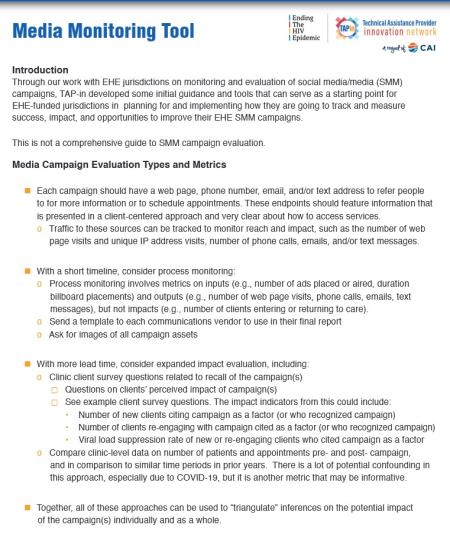Through our work with EHE jurisdictions on monitoring and evaluation of social media/media (SMM) campaigns, TAP-in developed some initial guidance and tools that can serve as a starting point for EHE-funded jurisdictions in planning for and implementing how they are going to track and measure success, impact, and opportunities to improve their EHE SMM campaigns.
Media Campaign Evaluation Types and Metrics
- Each campaign should have a web page, phone number, email, and/or text address to refer people to for more information or to schedule appointments. These endpoints should feature information that is presented in a client-centered approach and very clear about how to access services.
- Traffic to these sources can be tracked to monitor reach and impact, such as the number of web page visits and unique IP address visits, number of phone calls, emails, and/or text messages.
- With a short timeline, consider process monitoring:
- Process monitoring involves metrics on inputs (e.g., number of ads placed or aired, duration billboard placements) and outputs (e.g., number of web page visits, phone calls, emails, text messages), but not impacts (e.g., number of clients entering or returning to care).
- Send a template to each communications vendor to use in their final report
- Ask for images of all campaign assets
- With more lead time, consider expanded impact evaluation, including:
- Clinic client survey questions related to recall of the campaign(s)
- Questions on clients’ perceived impact of campaign(s)
- See example client survey questions. The impact indicators from this could include:
- Number of new clients citing campaign as a factor (or who recognized campaign)
- Number of clients re-engaging with campaign cited as a factor (or who recognized campaign)
- Viral load suppression rate of new or re-engaging clients who cited campaign as a factor
- Compare clinic-level data on number of patients and appointments pre- and post- campaign, and in comparison to similar time periods in prior years. There is a lot of potential confounding in this approach, especially due to COVID-19, but it is another metric that may be informative.
- Clinic client survey questions related to recall of the campaign(s)
- Together, all of these approaches can be used to “triangulate” inferences on the potential impact of the campaign(s) individually and as a whole.
Analyzing Metrics
| Metric | Notes |
| Reach/Impression | How efficient that platform is for your audience |
| Click/Reach | How effective the message is |
| Engagement/Reach | How viral the message is |
| Spend/Click | The cost of each action |
Definitions
- Campaign: Name or theme.
- Dates: Dates the ads ran.
- Engagements: Includes reactions, shares, and comments.
- Goal(s): Awareness, Behavior (call, click, text), Outcomes (get tested, engage in care, reach viral load suppression).
- Impressions: Number of times the post/ad was displayed. For website, use page views. For billboards radio, etc. use the number of boards/ads.
- Intended audience: Demographic information about audience.
- Platform: Social, digital, or conventional media space for campaign activity.
- Reach: Number of people who saw the post/ad. For website, use unique users. For billboards, radio, etc. use available estimates.
- Referrals/Clicks: Number of people who clicked for more info, etc. For billboards, radio, etc. use “for more info” call, text, website metrics.
- Spend: Amount of budget to place ads/boost posts on this platform.
This resource was developed by
Technical Assistance Provider Innovation Network (TAP-in)
